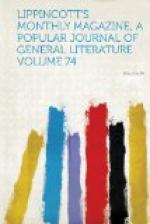[Illustration: Main building.]
A treasury meant to accommodate seven millions of dollars—three millions less than the Vienna outlay—still showed an aching void, which was but partially satisfied by the individual subscriptions of Philadelphians. It became necessary to sound the financial tocsin in the ears of all the Union. Congress, States, cities, counties, schools, churches, citizens and children were appealed to for subscriptions. The shares were fixed at the convenient size of ten dollars each, hardly the market-value of the stock-certificate, “twenty-four by twenty inches on the best bank-note paper,” which became the property of each fortunate shareholder on the instant of payment. But these seductive pictures belonged to a class of art with which the moneyed public had become since ’73 unhappily too familiar. They had to jostle, in the gallery of the stock-market, a vast and various collection exhaustive of the whole field of allegory, mythological and technical, and framed in the most bewitching aureoles of blue, red and green printer’s ink. It seemed in ’72 much more probable that the Coon Swamp and Byzantium Trans-Continental Railway would be able, the year after completion, to pay eight per cent. on fifty thousand dollars of bonds to the mile, sold at seventy in the hundred, than it did in ’75 that ten millions of fifty-cent tickets could be disposed of in six months at any point on the Continent. Thus it happened that the exchange of Mr. Spinner’s twenty square inches of allegory for the three square feet of Messrs. Ferris & Darley’s went on slowly, and it became painfully obvious that the walls of but an imperceptible minority of American homes would have the patriotic faith and fervor of their occupants attested a century hence by these capacious engravings, as that of a hundred years ago is by rusty muskets and Cincinnati diplomas.
Still, the stock did not altogether go a-begging. The adjacent State of New Jersey signed for the sum of $100,000, more remote New Hampshire and Connecticut for $10,000 each, and little Delaware for the same. Kansas gave $25,000. Five thousand were voted by the city of Wilmington, and a thin fusillade of ten-dollar notes played slowly from all points of the compass. This was kept up to the last, and with some increase of activity, but it was a mere affair of pickets, that could not be decisive.
Undismayed, the managers fought their way through fiscal brake and brier, the open becoming more discernible with each effort, till in February, 1876, Congress rounded off their strong box with the neat capping of a million and a half. The entire cost of administration and construction was thus covered, and the association distinguished from all its predecessors by the assurance of being able on the opening day to invite its thousands of guests to floors laden with the wealth of the world, but with not an ounce of debt.




